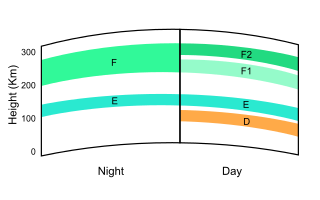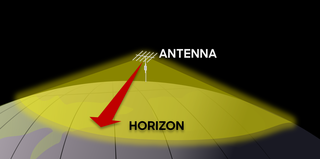
The ionosphere is the ionized part of the upper atmosphere of Earth, from about 48 km (30 mi) to 965 km (600 mi) above sea level, a region that includes the thermosphere and parts of the mesosphere and exosphere. The ionosphere is ionized by solar radiation. It plays an important role in atmospheric electricity and forms the inner edge of the magnetosphere. It has practical importance because, among other functions, it influences radio propagation to distant places on Earth. It also affects GPS signals that travel through this layer.

The Heaviside layer, sometimes called the Kennelly–Heaviside layer, named after Arthur E. Kennelly and Oliver Heaviside, is a layer of ionised gas occurring roughly between 90km and 150 km above the ground — one of several layers in the Earth's ionosphere. It is also known as the E region. It reflects medium-frequency radio waves. Because of this reflective layer, radio waves radiated into the sky can return to Earth beyond the horizon. This "skywave" or "skip" propagation technique has been used since the 1920s for radio communication at long distances, up to transcontinental distances.

In telecommunications, an atmospheric duct is a horizontal layer in the lower atmosphere in which the vertical refractive index gradients are such that radio signals are guided or ducted, tend to follow the curvature of the Earth, and experience less attenuation in the ducts than they would if the ducts were not present. The duct acts as an atmospheric dielectric waveguide and limits the spread of the wavefront to only the horizontal dimension.
The F region of the ionosphere is home to the F layer of ionization, also called the Appleton–Barnett layer, after the English physicist Edward Appleton and New Zealand physicist and meteorologist Miles Barnett. As with other ionospheric sectors, 'layer' implies a concentration of plasma, while 'region' is the volume that contains the said layer. The F region contains ionized gases at a height of around 150–800 km above sea level, placing it in the Earth's thermosphere, a hot region in the upper atmosphere, and also in the heterosphere, where chemical composition varies with height. Generally speaking, the F region has the highest concentration of free electrons and ions anywhere in the atmosphere. It may be thought of as comprising two layers, the F1 and F2 layers.
Ground waves are radio waves propagating parallel to and adjacent to the surface of the Earth, following the curvature of the Earth. This radiation is known as Norton surface wave, or more properly Norton ground wave, because ground waves in radio propagation are not confined to the surface.
In radio transmission maximum usable frequency (MUF) is the highest radio frequency that can be used for transmission between two points via reflection from the ionosphere at a specified time, independent of transmitter power. This index is especially useful in regard to shortwave transmissions.

A skip zone, also called a silent zone or zone of silence, is a region where a radio transmission can not be received. The zone is located between regions both closer and farther from the transmitter where reception is possible.

Line-of-sight propagation is a characteristic of electromagnetic radiation or acoustic wave propagation which means waves can only travel in a direct visual path from the source to the receiver without obstacles. Electromagnetic transmission includes light emissions traveling in a straight line. The rays or waves may be diffracted, refracted, reflected, or absorbed by the atmosphere and obstructions with material and generally cannot travel over the horizon or behind obstacles.

Medium frequency (MF) is the ITU designation for radio frequencies (RF) in the range of 300 kilohertz (kHz) to 3 megahertz (MHz). Part of this band is the medium wave (MW) AM broadcast band. The MF band is also known as the hectometer band as the wavelengths range from ten to one hectometers. Frequencies immediately below MF are denoted low frequency (LF), while the first band of higher frequencies is known as high frequency (HF). MF is mostly used for AM radio broadcasting, navigational radio beacons, maritime ship-to-shore communication, and transoceanic air traffic control.

In radio, longwave, long wave or long-wave, and commonly abbreviated LW, refers to parts of the radio spectrum with wavelengths longer than what was originally called the medium-wave broadcasting band. The term is historic, dating from the early 20th century, when the radio spectrum was considered to consist of longwave (LW), medium-wave (MW), and short-wave (SW) radio bands. Most modern radio systems and devices use wavelengths which would then have been considered 'ultra-short'.

High frequency (HF) is the ITU designation for the range of radio frequency electromagnetic waves between 3 and 30 megahertz (MHz). It is also known as the decameter band or decameter wave as its wavelengths range from one to ten decameters. Frequencies immediately below HF are denoted medium frequency (MF), while the next band of higher frequencies is known as the very high frequency (VHF) band. The HF band is a major part of the shortwave band of frequencies, so communication at these frequencies is often called shortwave radio. Because radio waves in this band can be reflected back to Earth by the ionosphere layer in the atmosphere – a method known as "skip" or "skywave" propagation – these frequencies are suitable for long-distance communication across intercontinental distances and for mountainous terrains which prevent line-of-sight communications. The band is used by international shortwave broadcasting stations (3.95–25.82 MHz), aviation communication, government time stations, weather stations, amateur radio and citizens band services, among other uses.
Anomalous propagation includes different forms of radio propagation due to an unusual distribution of temperature and humidity with height in the atmosphere. While this includes propagation with larger losses than in a standard atmosphere, in practical applications it is most often meant to refer to cases when signal propagates beyond normal radio horizon.

Sporadic E is an unusual form of radio propagation using a low level of the Earth's ionosphere that normally does not refract radio waves.
TV DX and FM DX is the active search for distant radio or television stations received during unusual atmospheric conditions. The term DX is an old telegraphic term meaning "long distance."
Radio propagation is the behavior of radio waves as they travel, or are propagated, from one point to another in vacuum, or into various parts of the atmosphere. As a form of electromagnetic radiation, like light waves, radio waves are affected by the phenomena of reflection, refraction, diffraction, absorption, polarization, and scattering. Understanding the effects of varying conditions on radio propagation has many practical applications, from choosing frequencies for amateur radio communications, international shortwave broadcasters, to designing reliable mobile telephone systems, to radio navigation, to operation of radar systems.

In radio communication, skywave or skip refers to the propagation of radio waves reflected or refracted back toward Earth from the ionosphere, an electrically charged layer of the upper atmosphere. Since it is not limited by the curvature of the Earth, skywave propagation can be used to communicate beyond the horizon, at intercontinental distances. It is mostly used in the shortwave frequency bands.

Atmospheric diffraction is manifested in the following principal ways:
Non-line-of-sight (NLOS) radio propagation occurs outside of the typical line-of-sight (LOS) between the transmitter and receiver, such as in ground reflections. Near-line-of-sight conditions refer to partial obstruction by a physical object present in the innermost Fresnel zone.
The Earth–ionosphere waveguide refers to the phenomenon in which certain radio waves can propagate in the space between the ground and the boundary of the ionosphere. Because the ionosphere contains charged particles, it can behave as a conductor. The earth operates as a ground plane, and the resulting cavity behaves as a large waveguide.
This is an index to articles about terms used in discussion of radio propagation.










